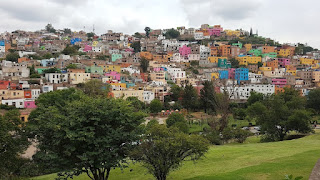El dia de los muertos - a colourful day of celebrating life and death in Guanajuato, Mexico
 Exactly a year ago, I was on my way to Guanajuato, Mexico to celebrate the Day of the Dead - El dia de los muertos, as they say. We drove through picturesque scenery of mountains, arriving at this colonial town (known as one of the pueblo magico -magical town- of the region) through a dark tunnel, only to come out on the other side to a whole other view. A pueblo magico is a town known for being picturesque, with rich architecture, legends, history, traditions and customs. Guanajuato is definitely a magical town. One of the first buildings that caught our eye was a bright yellow church with dark red trims, Parroquia de Basílica Colegiata de Nuestra Señora de Guanajuato, as well as the entourage of colourful houses stacked on the hills like lego.
Exactly a year ago, I was on my way to Guanajuato, Mexico to celebrate the Day of the Dead - El dia de los muertos, as they say. We drove through picturesque scenery of mountains, arriving at this colonial town (known as one of the pueblo magico -magical town- of the region) through a dark tunnel, only to come out on the other side to a whole other view. A pueblo magico is a town known for being picturesque, with rich architecture, legends, history, traditions and customs. Guanajuato is definitely a magical town. One of the first buildings that caught our eye was a bright yellow church with dark red trims, Parroquia de Basílica Colegiata de Nuestra Señora de Guanajuato, as well as the entourage of colourful houses stacked on the hills like lego.
We visited the mummy museum, where we saw the carefully preserved bodies of inhabitants, including a fetus. Many were still wearing the same clothes as the day they met their fate, hair and jewelry intact and most had a hollow, sunken face with their mouth in the shape of an O, like from the movie Scream.
No trip was complete without food. We tried tortas, a sandwich with white bread filled with meat, cheese, avocado and of course unlimited salsa picante (spicy sauce) to our heart's desire. While delicious, this was not a typical meal of the region. While in Guanajuato, we visited a park where a man had a sandwich stand - guacamayas - named after the macaw parrot's colours. It included: a bun, avocado, tomato, egg, chicharron (pork rind) and salsa.
At night, we took a tour through the winding cobblestone streets and sang folklore songs, the group growing bigger as it made its way through the town until we became a big crowd. Candles were lit in the streets and set a dim glow across town.
The next day, the streets were covered in a "carpet of death", el tapete de la muerte, using rice, wood shavings, flowers (especially marigolds) and colourful powder in blue, pink, purple, green and orange. Artwork depicting traditional Mexican culture took over the streets. Afterwards, there was a desfile of catrinas, a parade of people dressed as skeletons and alebrijes, colourful and mystical creatures representing traditional folklore art. Women had skulls painted on their face and they wore extravagant costumes with wings, long elaborate dresses, and headpieces filled with flowers and feathers.

We visited one of the cemeteries, el Panteon, where people of all ages, from children to seniors, came to pay their respects to loved ones who had passed. The setup was different from what I'm used to, with tombstones in the ground. This one reminded me of the library in the movie Beauty and the Beast, where Belle uses her ladder to reach the upper shelves of books. People were using a ladder to access the higher "lot" that had been assigned to their loved one, offering sweets, flowers, a picture or other items in their memory.

The basilica in the main plaza, the central meeting point in town, had a special ceremony to honour our late loved ones: I named my grandma, both aunts and granddad. They gave everyone a white balloon, where you wrote the names of the people who have passed and, as the bell chimed, we all released our balloons in unison, sending the memories of our loved ones up to heaven, where they belong. Little did I know that less than a year later, I would have added my Nanny's name. She was 96 years old and it was her time to rest, but I selfishly wanted her to be in my life forever.
(I try not to think about the less symbolic consequence of where these deflated balloons would likely end up, polluting wherever they landed.)
Watching the movie Coco helped me understand the significance of this celebration, not to be compared with our Halloween. It is a celebration and honouring of loved ones who have passed but who remain in our hearts and our lives forever.
Comments
Post a Comment